Junsu Cho
Dynamic Multi-Behavior Sequence Modeling for Next Item Recommendation
Jan 28, 2023Abstract:Sequential Recommender Systems (SRSs) aim to predict the next item that users will consume, by modeling the user interests within their item sequences. While most existing SRSs focus on a single type of user behavior, only a few pay attention to multi-behavior sequences, although they are very common in real-world scenarios. It is challenging to effectively capture the user interests within multi-behavior sequences, because the information about user interests is entangled throughout the sequences in complex relationships. To this end, we first address the characteristics of multi-behavior sequences that should be considered in SRSs, and then propose novel methods for Dynamic Multi-behavior Sequence modeling named DyMuS, which is a light version, and DyMuS+, which is an improved version, considering the characteristics. DyMuS first encodes each behavior sequence independently, and then combines the encoded sequences using dynamic routing, which dynamically integrates information required in the final result from among many candidates, based on correlations between the sequences. DyMuS+, furthermore, applies the dynamic routing even to encoding each behavior sequence to further capture the correlations at item-level. Moreover, we release a new, large and up-to-date dataset for multi-behavior recommendation. Our experiments on DyMuS and DyMuS+ show their superiority and the significance of capturing the characteristics of multi-behavior sequences.
Beyond Learning from Next Item: Sequential Recommendation via Personalized Interest Sustainability
Sep 14, 2022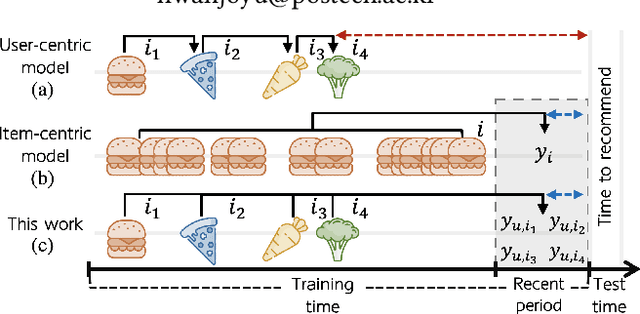
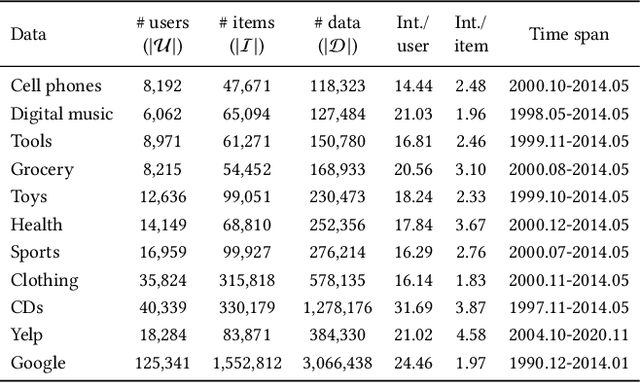
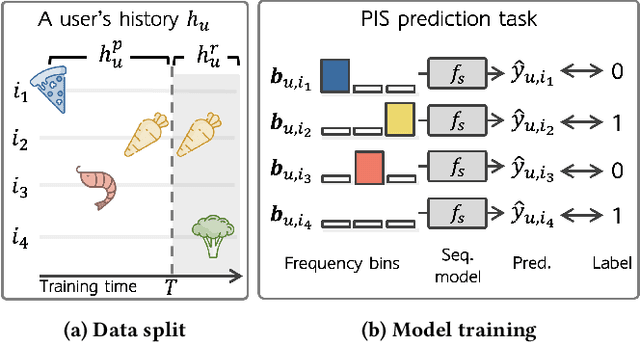
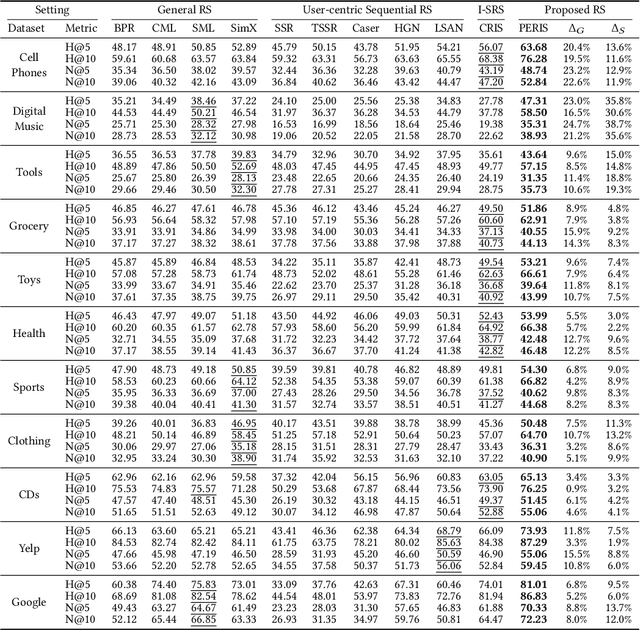
Abstract:Sequential recommender systems have shown effective suggestions by capturing users' interest drift. There have been two groups of existing sequential models: user- and item-centric models. The user-centric models capture personalized interest drift based on each user's sequential consumption history, but do not explicitly consider whether users' interest in items sustains beyond the training time, i.e., interest sustainability. On the other hand, the item-centric models consider whether users' general interest sustains after the training time, but it is not personalized. In this work, we propose a recommender system taking advantages of the models in both categories. Our proposed model captures personalized interest sustainability, indicating whether each user's interest in items will sustain beyond the training time or not. We first formulate a task that requires to predict which items each user will consume in the recent period of the training time based on users' consumption history. We then propose simple yet effective schemes to augment users' sparse consumption history. Extensive experiments show that the proposed model outperforms 10 baseline models on 11 real-world datasets. The codes are available at https://github.com/dmhyun/PERIS.
Unsupervised Proxy Selection for Session-based Recommender Systems
Jul 08, 2021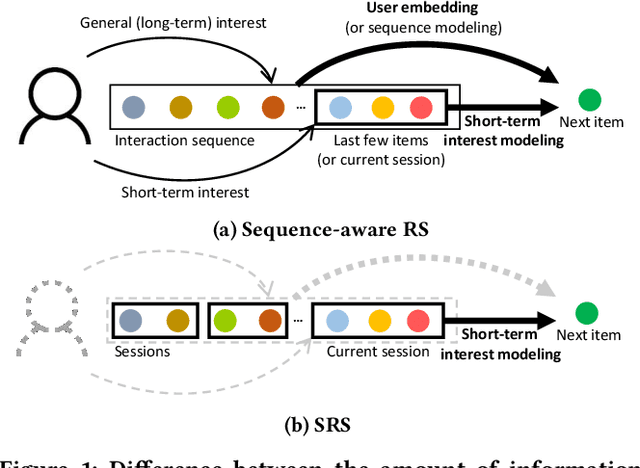

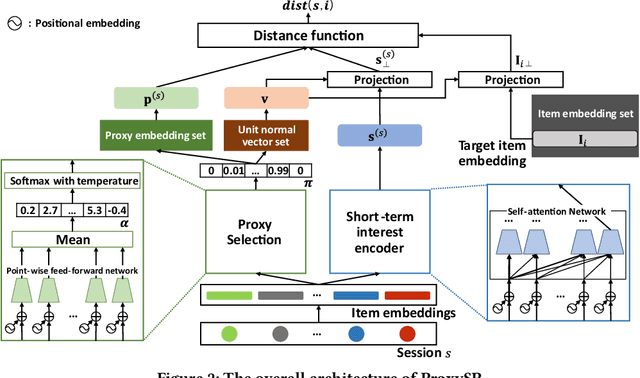
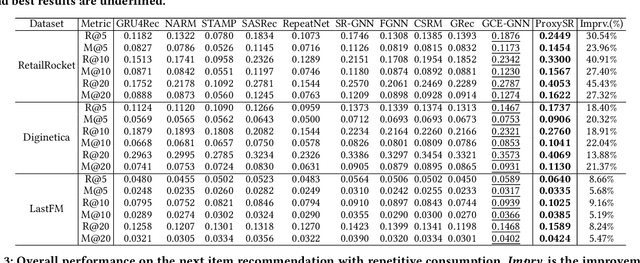
Abstract:Session-based Recommender Systems (SRSs) have been actively developed to recommend the next item of an anonymous short item sequence (i.e., session). Unlike sequence-aware recommender systems where the whole interaction sequence of each user can be used to model both the short-term interest and the general interest of the user, the absence of user-dependent information in SRSs makes it difficult to directly derive the user's general interest from data. Therefore, existing SRSs have focused on how to effectively model the information about short-term interest within the sessions, but they are insufficient to capture the general interest of users. To this end, we propose a novel framework to overcome the limitation of SRSs, named ProxySR, which imitates the missing information in SRSs (i.e., general interest of users) by modeling proxies of sessions. ProxySR selects a proxy for the input session in an unsupervised manner, and combines it with the encoded short-term interest of the session. As a proxy is jointly learned with the short-term interest and selected by multiple sessions, a proxy learns to play the role of the general interest of a user and ProxySR learns how to select a suitable proxy for an input session. Moreover, we propose another real-world situation of SRSs where a few users are logged-in and leave their identifiers in sessions, and a revision of ProxySR for the situation. Our experiments on real-world datasets show that ProxySR considerably outperforms the state-of-the-art competitors, and the proxies successfully imitate the general interest of the users without any user-dependent information.
Learning Heterogeneous Temporal Patterns of User Preference for Timely Recommendation
Apr 29, 2021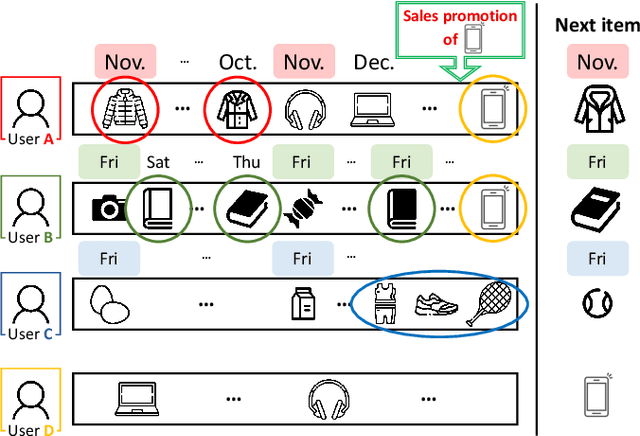

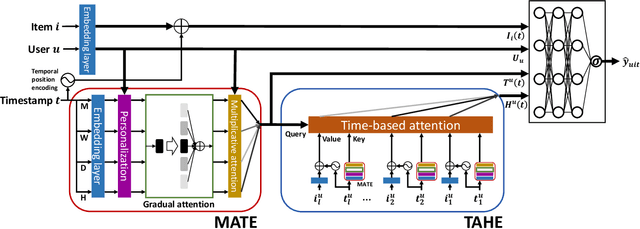
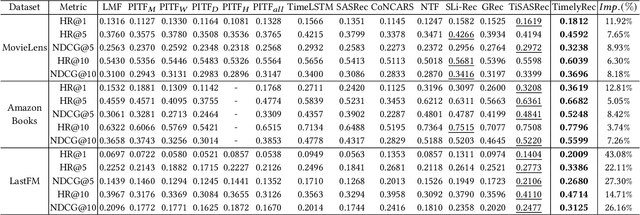
Abstract:Recommender systems have achieved great success in modeling user's preferences on items and predicting the next item the user would consume. Recently, there have been many efforts to utilize time information of users' interactions with items to capture inherent temporal patterns of user behaviors and offer timely recommendations at a given time. Existing studies regard the time information as a single type of feature and focus on how to associate it with user preferences on items. However, we argue they are insufficient for fully learning the time information because the temporal patterns of user preference are usually heterogeneous. A user's preference for a particular item may 1) increase periodically or 2) evolve over time under the influence of significant recent events, and each of these two kinds of temporal pattern appears with some unique characteristics. In this paper, we first define the unique characteristics of the two kinds of temporal pattern of user preference that should be considered in time-aware recommender systems. Then we propose a novel recommender system for timely recommendations, called TimelyRec, which jointly learns the heterogeneous temporal patterns of user preference considering all of the defined characteristics. In TimelyRec, a cascade of two encoders captures the temporal patterns of user preference using a proposed attention module for each encoder. Moreover, we introduce an evaluation scenario that evaluates the performance on predicting an interesting item and when to recommend the item simultaneously in top-K recommendation (i.e., item-timing recommendation). Our extensive experiments on a scenario for item recommendation and the proposed scenario for item-timing recommendation on real-world datasets demonstrate the superiority of TimelyRec and the proposed attention modules.
Sparse Network Inversion for Key Instance Detection in Multiple Instance Learning
Sep 08, 2020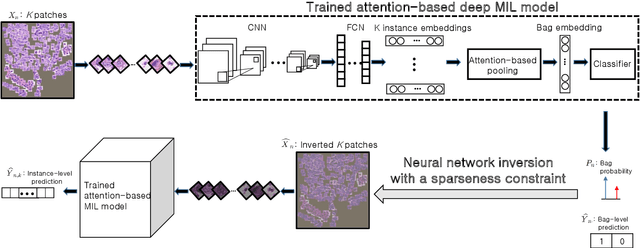
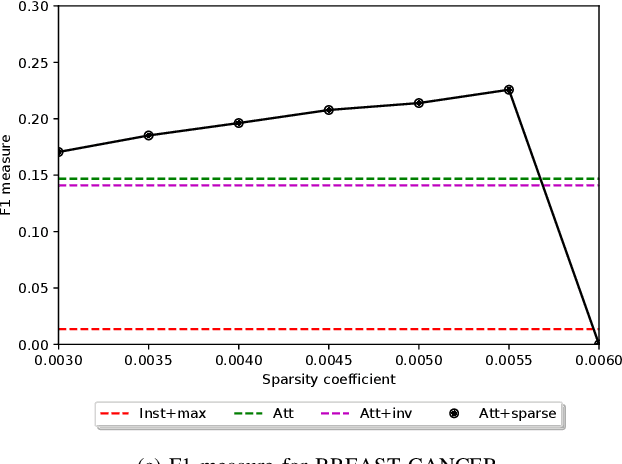
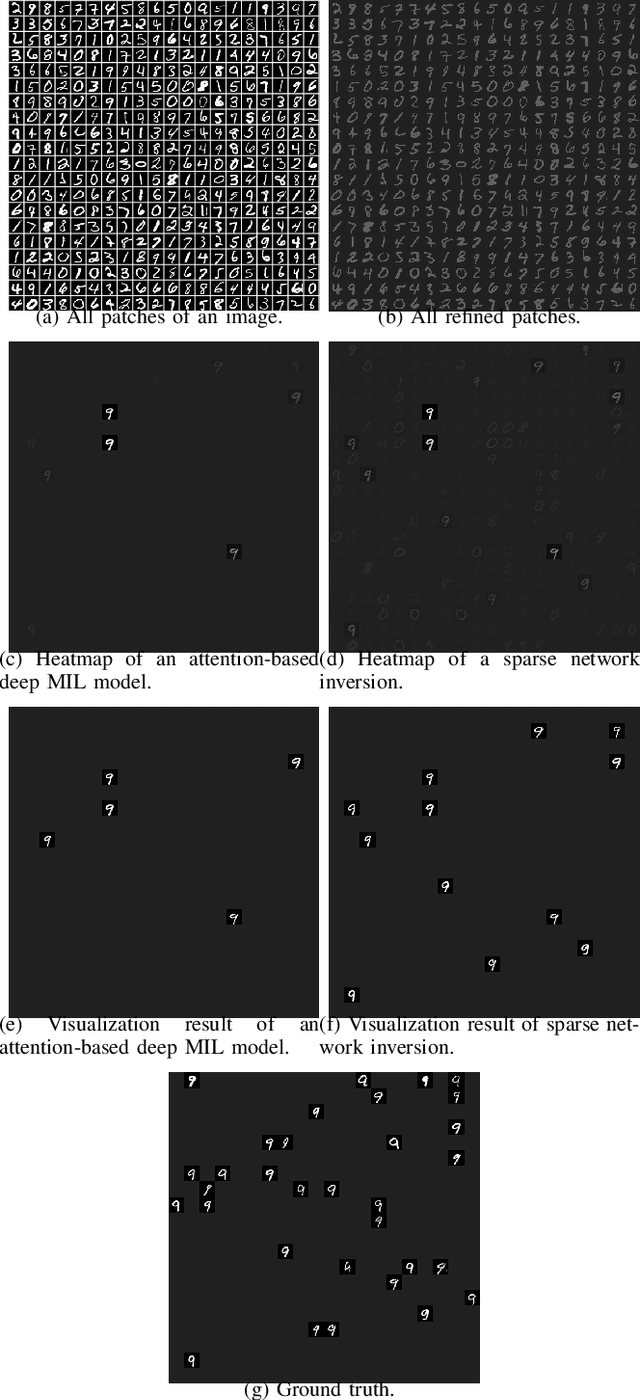
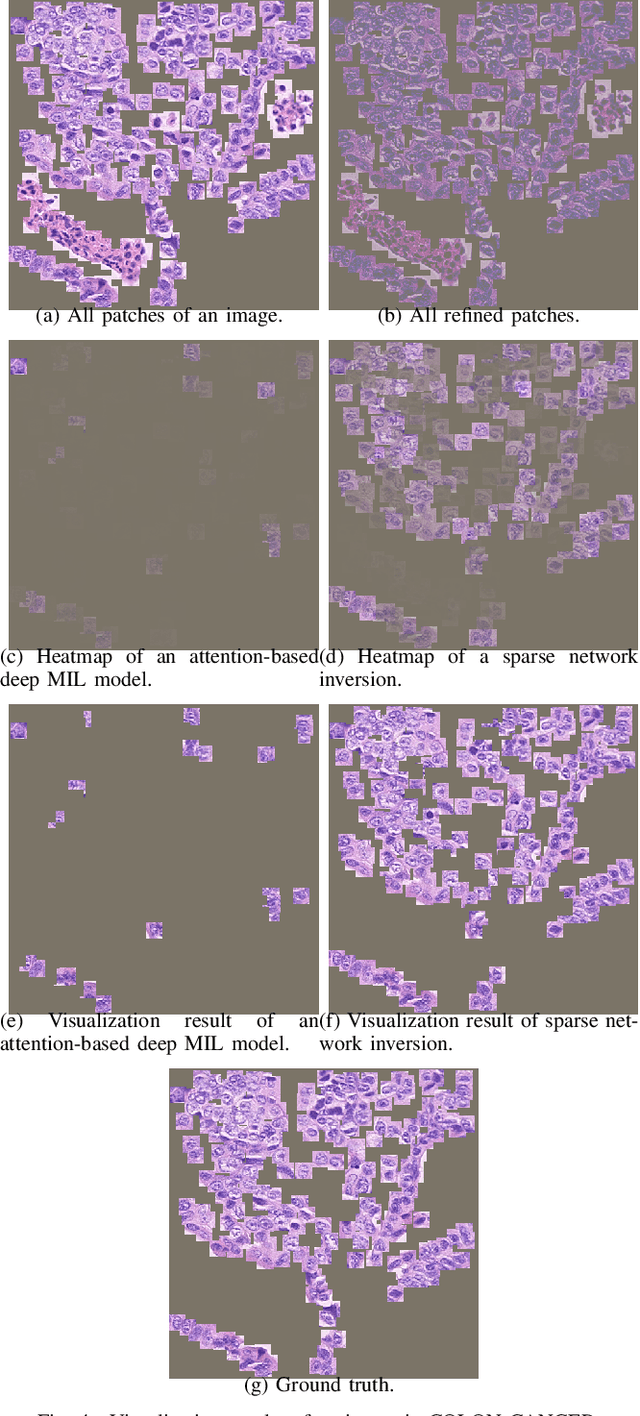
Abstract:Multiple Instance Learning (MIL) involves predicting a single label for a bag of instances, given positive or negative labels at bag-level, without accessing to label for each instance in the training phase. Since a positive bag contains both positive and negative instances, it is often required to detect positive instances (key instances) when a set of instances is categorized as a positive bag. The attention-based deep MIL model is a recent advance in both bag-level classification and key instance detection (KID). However, if the positive and negative instances in a positive bag are not clearly distinguishable, the attention-based deep MIL model has limited KID performance as the attention scores are skewed to few positive instances. In this paper, we present a method to improve the attention-based deep MIL model in the task of KID. The main idea is to use the neural network inversion to find which instances made contribution to the bag-level prediction produced by the trained MIL model. Moreover, we incorporate a sparseness constraint into the neural network inversion, leading to the sparse network inversion which is solved by the proximal gradient method. Numerical experiments on an MNIST-based image MIL dataset and two real-world histopathology datasets verify the validity of our method, demonstrating the KID performance is significantly improved while the performance of bag-level prediction is maintained.
 Add to Chrome
Add to Chrome Add to Firefox
Add to Firefox Add to Edge
Add to Edge